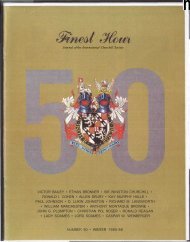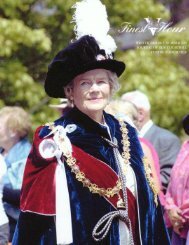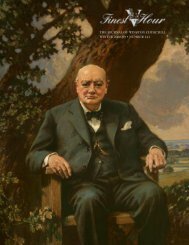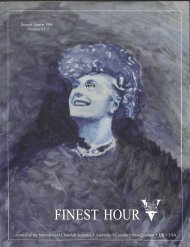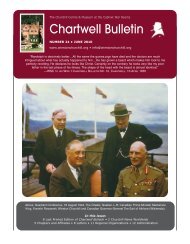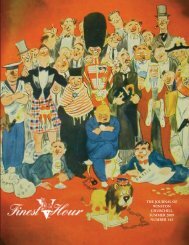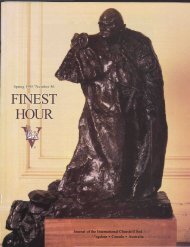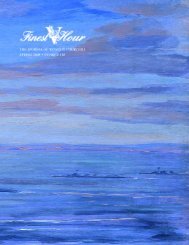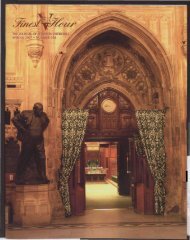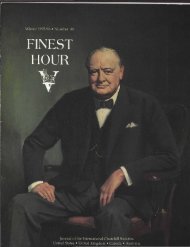'.."• '"'«••,. v " • • • -"-T*/^*-.. : ^^iSjj^&w£}The Battle of Britain took placein the skies over southeastEngland between July andOctober 1940. The Roll of Honour inthe Battle of Britain Memorial Chapelin Westminster Abbey lists the namesof 1503 Royal Air Force and Fleet AirArm personnel killed in the battle.German records are far from completebut authoritative estimates putthe number of Luftwaffe airmenkilled in excess of 2600. The RAF lost1017 aircraft. Luftwaffe losses havebeen given as 1882 aircraft.After the end of World War II,the 15th of September 1945 was designatedas the first "Battle of BritainDay." Three hundred RAF fighter aircrafttook part in a fly-past over centralLondon and ninety RAF stationswere opened to the public (the firsttime there had been any public accesssince the 1939 Empire Air Day).Thereafter, both the fly-past—alwaysled by the immortal Spitfire andMr. Hall is FH's Features EditorHurricane—and the open days becamean annual event although thenumber of participating aircraft andairfields was gradually reduced. In1959 the Spitfire taking part in the flypastdeveloped an engine fault andhad to make a forced landing on acricket ground in Bromley. There wasan outcry with a vociferous publicsafety lobby demanding that allflights by "ancient" single-enginedaircraft over densely populated areasshould be banned, countered by anequally vehement group arguing thatthey should be continued. Nevertheless,after the September 1961 "Battleof Britain Day" fly-past, the regularceremonial flight over central Londonwas discontinued and the RAF withdrewits then only remaining airworthySpitfire (PM 631) and Hurricane(LF 363) to form an Historic AircraftFlight based at Horsham St. Faith inNorfolk. The two aircraft continuedto make a limited number of appearancesat RAF open days around thecountry but by 1963 the number ofFINE<strong>ST</strong> <strong>HOUR</strong> 96/40these had dropped to just fifteen.Aware that it was custodian ofpriceless, and hugely popular, piecesof national heritage—and also awarethat a single example of each aircrafttype provided no cover at all againstany kind of mishap—the RAF setabout increasing its stock of airworthyexamples. The cost of restoringhistoric aircraft featured high on thepolitical agenda during a periodwhen defence expenditure was constantlyunder scrutiny and the RAFwere able to make only slow and limitedprogress towards their objective.By 1965, however, the HistoricAircraft Flight had been boosted tofour Spitfires—but still only the singleHurricane—and was able toincrease its participation in air displaysthroughout the summermonths. A huge bonus arrived in 1968when Harry Saltzmam and Ben Fiszdecided to make their epic featurefilm, "Battle of Britain." The filmcompany paid handsomely to hire theRAF's five airworthy aircraft and also
to restore several gate-guardian andmuseum examples to flying condition.As a result the Flight secured anadditional Spitfire and the muchneededsecond Hurricane. At aroundthe same time, a much-modifiedLancaster (PA 474), which had beenused by the Cranfield College ofAeronautics, was withdrawn fromservice and earmarked for static exhibitionat the Royal Air Force Museumat Hendon after restoration to aWorld War II configuration. PA 474had in fact missed the war, havingbeen built in mid-1945 and allocatedfor the Far East "Tiger Force,"not participatingin hostilities before VJ-Day.The RAF argued that a more historicairframe—of which there wereseveral doing gate guardian duty—would be more appropriate for theRAF Museum and that PA 474 shouldbe maintained in flying conditionwithin the Historic Aircraft Flight.This was a hugely popular moveamongst not only ex-members ofBomber Command but with theBritish public as a whole. Whilst lossesof life and aircraft during the fourmonths of the Battle of Britain hadbeen sobering enough, they hadformed only the "end of the beginning"in the context of 56,000 Britishand Commonwealth aircrew fatalitiesand around 600,000 German lives lostduring the bomber offensive of thefollowing four and one-half years.The Historic Aircraft Flight wasrenamed the Battle of BritainMemorial Flight in 1973, and movedOPPOSITE: A Hurricane (top), the Lancaster and a Spitfire approaching Jersey Airport for theFlight's annual display over the Channel Islands. BELOW: P 7350, oldest airworthy Spitfire,entered service in August 1940 and fought with 266 and 603 Squadrons; she still carries patchesover bullet holes sustained in combat. She was in the museum at RAF Colerne before beingmade airworthy for the film "Battle of Britain," after which she was presented to the BBMF.BOTTOM: Lancaster PA 474 flying over Lincoln Cathedral. The plane was adopted by Lincolnand has since worn the city's crest on the port side of the forward fuselage. During 1995-96,PA 474 was fitted with a brand new main spar which will extend her flying life well into thenext millennium. Photographs in this article are by courtesy of Lincolnshire's LancasterAssociation (Ltd.). A donation has been accepted by the Committee in lieu of copyright fees..Skinto a purpose-built hangar at its currentbase, RAF Coningsby inLincolnshire, in 1976. Thus it celebratesthis year twenty-one years ofsettled existence. Its public esteem isnow surely such that it must beuntouchable by any politician seekingto further reduce defence expenditurefor at least "a thousand years."The present aircraft strength isthe Lancaster, four Spitfires, twoHurricanes and a Dakota — the latterhaving been acquired in 1993 to representthe important role of that typeduring the latter half of World War II.The BBMF's Dakota (ZA 947) is amost appropriate example, havingpreviously served with the UnitedStates Air Force, the Royal CanadianAir Force and the Royal AircraftEstablishment before coming toConingsby.Aircrew doing a tour of dutywith the Battle of Britain MemorialFlight are all volunteers — and thereis a long waiting list of aspirants!Pilots, now used only to flying modernaircraft with a tricycle undercarriage,have to do a course of trainingto fly the historic "tail-draggers." Avenerable Chipmunk trainer is keptby the Flight to provide "oppositeaction" take-off and landing experiencefor the fighter pilots and theDakota serves in a similar role for theLancaster pilots. It simply would notdo for a "pilot-error" accident tooccur to any of these priceless aircraft.A twenty-strong support andmaintenance groundcrew, also volunteers,keeps the aircraft in immaculateorder. BBMF aircraft participated inover 500 events during 1995, includingthe Lancaster dropping a millionpoppies over The Mall on VJ-Day.The Flight's hangar at Coningsbyis open to the public on everyweekday; more aircraft can usually beseen during the winter months. TheVisitor Centre, operated jointly by theRAF and Lincolnshire CountyCouncil, has a small but interestingexhibition and well-stocked souvenirshop dominated by a large portrait ofSir <strong>Winston</strong> <strong>Churchill</strong>, above the quotation,"Never in the field of humanconflict was so much owed by somany to so few."gjFINE<strong>ST</strong> <strong>HOUR</strong> 96/41



